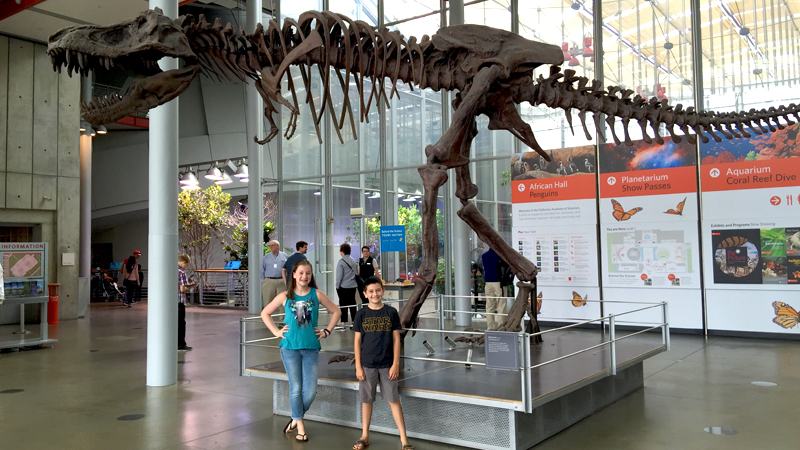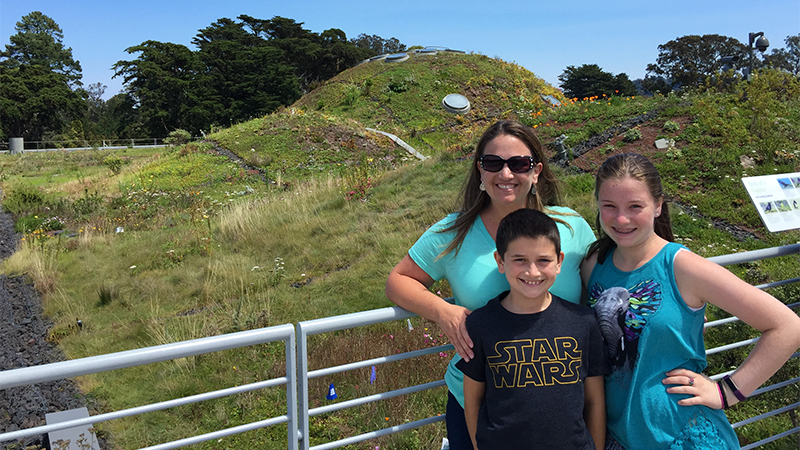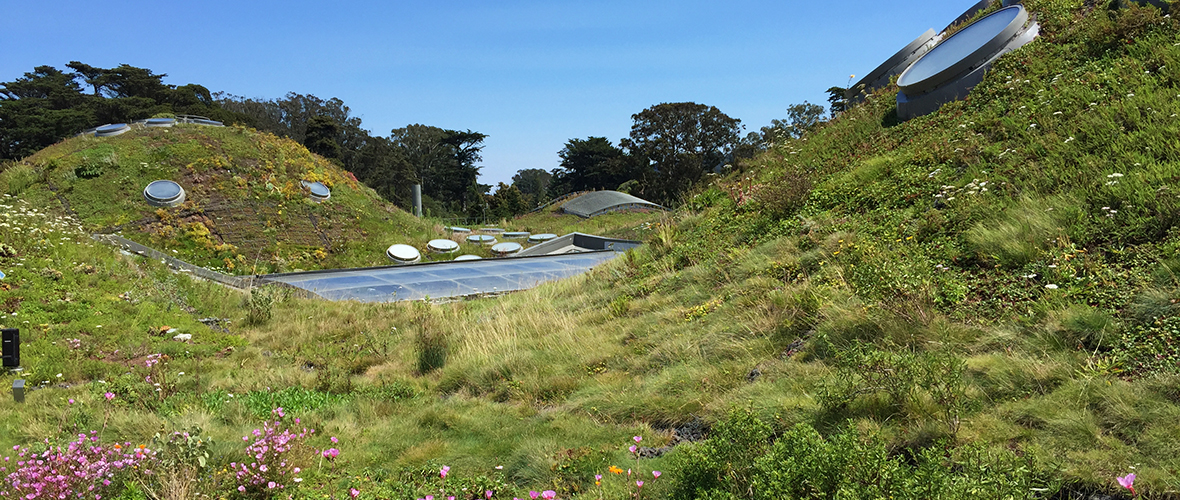
When Brin and I decided to turn Jerry Day 2016 into an entire weekend family adventure, we also bought California Academy of Sciences passes. We visited the Golden Gate Park science museum when the kids were little, but it had been at least six years, and Carter didn’t remember the museum at all — so we were pretty excited to visit again!
The California Academy of Sciences is the only place on Earth to house an aquarium, planetarium, and natural history museum — all under one living roof. It is a renowned scientific and educational institution dedicated to exploring, explaining, and sustaining life on Earth.
While we LOVED exploring the Osher Rainforest, were awestruck by the planetarium show, and spent hours in the Steinhart Aquarium, the Shake Shack earthquake simulator was one of the coolest experiences!
We also spent quite a bit of time at the Shark Lagoon, watching rays, sharks, and fish glide and swim through the water, and even more time watching the penguins play and splash.
With all of the changes that have been made to the California Academy of Sciences over the years, I was really happy to see they have kept the Tusher African Hall with dioramas of African wildlife and splashing penguins — I still have vivid memories of walking through this area as a small child and thinking the animals were real.

Because it was sunny and beautiful at the time, we also spent a lot of time on the roof — the living roof. Not only are there fantastic views of Golden Gate Park from the roof, there are also seven rolling, grassy hills, wildflowers, and native plants.
Architect Renzo Piano’s vision for the Academy is perhaps most perfectly expressed by the living roof. The goal, as he described it, was to ‘lift up a piece of the park and put a building under’ — to blend seamlessly into Golden Gate’s natural setting.
The roof’s seven hills are lined with 50,000 porous, biodegradable vegetation trays made from tree sap and coconut husks. An estimated 1.7 million plants fill the trays, their roots interlocking to create an extraordinary oasis for birds, insects, people, and other creatures.
Weather stations on the roof monitor wind, rain, and changes in temperature to help inform the building’s automated systems and skylights, keeping rainforest temperatures just right, the interior piazza cool and comfortable, and natural light streaming to the exhibits below.

Kimball Natural History Museum
The Kimball Natural History Museum explores some of the most significant discoveries and issues of our time. Learn what earthquakes tell us about the movement of tectonic plates, explore majestic dioramas of African landscapes and animals, compare fossils of our early human relatives, and see adaptations that make life possible even in the harshest environments — all while strolling beneath the bones of some of the planet’s largest inhabitants.
While we all enjoyed learning more about the earth, animals, and the evolution of our own species, our favorite part of Natural History Museum was the The Shake Shack — an earthquake simulator that looks just like a Victorian home in San Francisco (with great views), and replicates the shaking, rattling, and rolling of the 1906 and 1989 earthquakes that rocked the San Francisco Bay Area.
Morrison Planetarium
The Morrison Planetarium is one of the largest and most advanced all-digital planetarium domes in the world. Inside the dome one of the most accurate digital Universes ever created is displayed.
From faraway galaxies to the workings of our own planet, you’ll experience the cosmos like never before. Every star or galaxy a viewer encounters in the planetarium precisely mirrors a real-world counterpart, and when this virtual cosmos is projected onto Morrison’s 75-foot-diameter screen, the dome itself seems to disappear, resulting in a uniquely immersive experience.
We were blown away by the planetarium! Once inside, we walked up a steep staircase and chose our seats. The seats are stadium-style and really comfortable — if you’re tired, you may get too comfortable and take a little nap! When we sat down, we were surrounded by screens and illusion of space, even before the show started was sorts of weird feeling.
While we waited for all of the seats to fill up, a staff member chatted with us about space and told a bunch of silly, nerdy science jokes and we all were cracking up. The kids even wrote some of them down to share with their friends.
When the lights turned off and the show began I was in awe. Our experience with the Morrison Planetarium was unlike anything any of had experienced before. It was almost like being in space.
One thing to note: Planetarium show tickets are included with your general admission ticket, but there is limited seating, so you still need to reserve them at the planetarium kiosk.
The Osher Rainforest
The Osher Rainforest is a lush, four-story rainforest housed in a 90-foot glass dome. From free-flying birds and and hundreds of butterflies, to exotic reptiles and giant Amazonian fish, the rainforest is teeming with life from some of the most biodiverse places on Earth.
The rainforest dome was our first stop. The rainforest doors open after the museum, so we were one of the first families in line and were able to check out the tidepool exhibit while we waited. When the rainforest opened, we followed the spiral path around the edges of the dome, passing incredible animals and stunning tropical plants.
Each of the three levels we walked through represented a different rainforest ecosystem: a Bornean forest floor, a Madagascan mid-story, and the canopy of a Costa Rican forest.
The kids LOVED this exhibit! While walking from one end of the exhibit to another only takes a few minutes, trust me when I say you’ll spend at least a half an hour, probably much more, exploring everything there is to see and chasing butterflies! Every time we visit this museum, I am amazed by this immersive exhibit, and so were Natalie and Carter — they loved seeing the frogs, snakes, and other tropical animals.
Once you reach the top of the Osher Rainforest, the only way out is by elevator, which takes you down four stories beneath the rainforest floor and through the Amazon Flooded Forest tunnel.
One thing to note: Inside the Osher Rainforest exhibit it is hot and humid and you feel it immediately, so dress in layers. Also this is a one-way exhibit — once you enter you must travel all the way through the exhibit to leave and there are no restrooms inside.
The Steinhart Aquarium
The Steinhart Aquarium is one of the most advanced and biologically diverse aquariums in the world, home to the world’s deepest indoor living coral reef, an albino alligator, a colony of African penguins, a shark lagoon and more than 38,000 live animals representing over 900 species.
We’ve been to a lot of aquariums over the years — the Monterey Bay Aquarium, the Aquarium of the Pacific, and the Aquarium of the Bay at Pier 39 to name a few — and the Steinhart Aquarium is one of the best we have ever visited. The aquarium is so large, that sometimes it feels like you could get lost in the exhibits for hours.
The aquarium is stunning. From the brightly colored coral and diverse tanks of fish and sea creatures, to the jellyfish exhibits and deep sea creatures, we followed the kids from tank to tank, peering in the windows and getting glimpses of vibrant sea habitats and beautiful, yet weird creatures of the deep.
We also made time to visit Claude, the albino alligator, and the Discovery Tidepool, where we were able to get up close and personal with the coastal creatures that call California tidepools home and touch some sea life!
Know Before You Go
- The California Academy of Sciences is located in Golden Gate Park at 55 Music Concourse Drive, San Francisco, California 94118.
- General Admission tickets include access to all museum and aquarium exhibits — including the rainforest, planetarium, and living roof, as well as a wide range of daily programs. Tickets range from $34.95/adult to $24.95/child.
- The science museum is open Monday through Saturday from 9:30 am to 5:00 pm, and Sunday from 11:00 am to 5:00 pm.
- All San Francisco residents receive free admission on two designated weekends each year — in fall and spring, determined by zip code of residence — as part of the Neighborhood Free Weekends program.
- As part of the Quarterly Free Sundays program, admission is free to the general public four Sundays a year. Early arrival is recommended due to high demand.
- There are two dining options at the museum, The Terrace and The Academy Café.
- The closest parking facility to the California Academy of Sciences is the Music Concourse Parking Facility, located on Fulton Street and 10th Avenue. It has capacity for 800, but on weekends and holidays, the garage often fills to capacity early in the day.
- Get information on getting to the Academy of Sciences with public transportation and by bicycle, and get driving directions.































